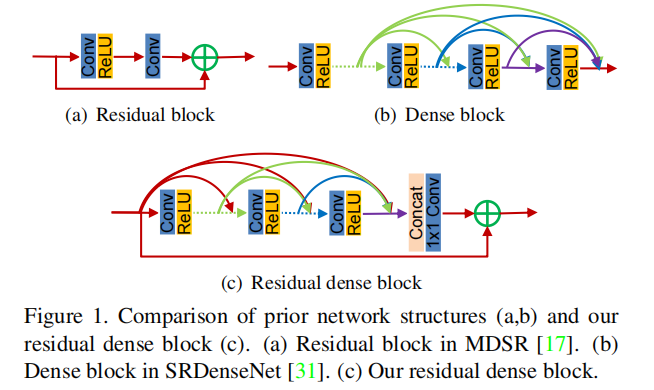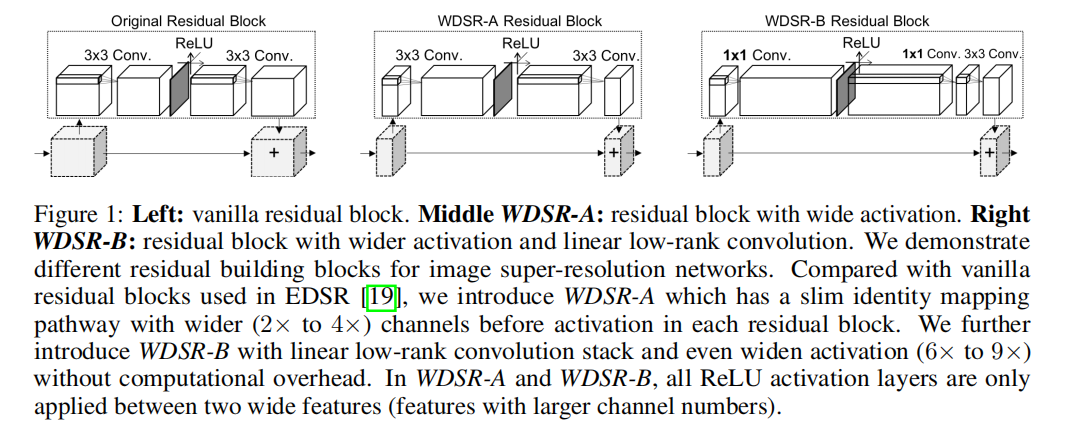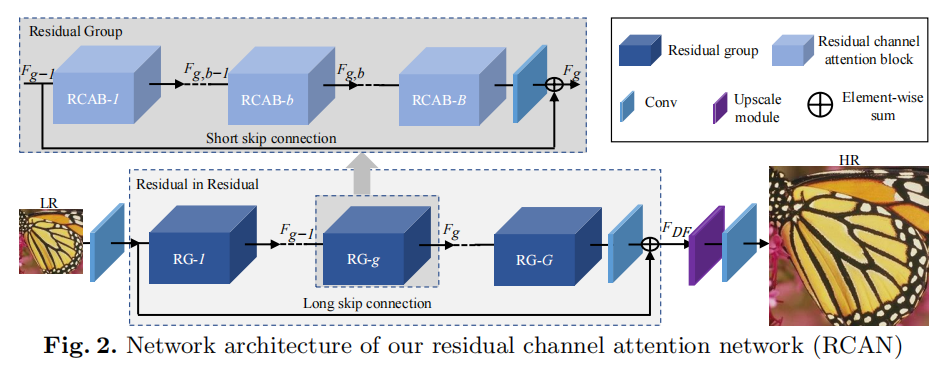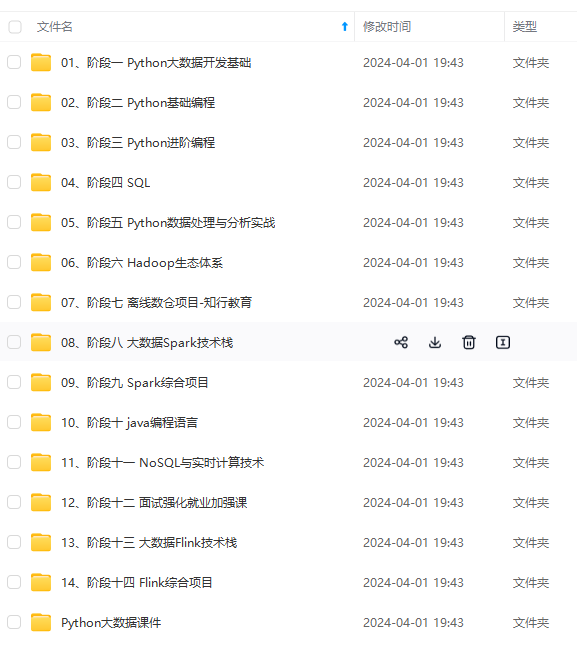class Block(nn.Module):
def __init__(self, input_channel=64, output_channel=64, kernel_size=3, stride=1, padding=1):
super().init()
self.layer = nn.Sequential(
nn.Conv2d(input_channel, output_channel, kernel_size, stride, bias=False, padding=1),
nn.BatchNorm2d(output_channel),
nn.PReLU(),
nn.Conv2d(output_channel, output_channel, kernel_size, stride, bias=False, padding=1),
nn.BatchNorm2d(output_channel)
)
def forward(self, x0):
x1 = self.layer(x0)
return x0 + x1
class Generator(nn.Module):
def __init__(self, scale=2):
super().init()
self.conv1 = nn.Sequential(
nn.Conv2d(3, 64, 9, stride=1, padding=4),
nn.PReLU()
)
self.residual_block = nn.Sequential(
Block(),
Block(),
Block(),
Block(),
Block(),
)
self.conv2 = nn.Sequential(
nn.Conv2d(64, 64, 3, stride=1, padding=1),
nn.BatchNorm2d(64),
)
self.conv3 = nn.Sequential(
nn.Conv2d(64, 256, 3, stride=1, padding=1),
nn.PixelShuffle(scale),
nn.PReLU(),
nn.Conv2d(64, 256, 3, stride=1, padding=1),
nn.PixelShuffle(scale),
nn.PReLU(),
)
self.conv4 = nn.Conv2d(64, 3, 9, stride=1, padding=4)
def forward(self, x):
x0 = self.conv1(x)
x = self.residual_block(x0)
x = self.conv2(x)
x = self.conv3(x + x0)
x = self.conv4(x)
return x
class DownSalmpe(nn.Module):
def __init__(self, input_channel, output_channel, stride, kernel_size=3, padding=1):
super().init()
self.layer = nn.Sequential(
nn.Conv2d(input_channel, output_channel, kernel_size, stride, padding),
nn.BatchNorm2d(output_channel),
nn.LeakyReLU(inplace=True)
)
def forward(self, x):
x = self.layer(x)
return x
class Discriminator(nn.Module):
def __init__(self):
super().init()
self.conv1 = nn.Sequential(
nn.Conv2d(3, 64, 3, stride=1, padding=1),
nn.LeakyReLU(inplace=True),
)
self.down = nn.Sequential(
DownSalmpe(64, 64, stride=2, padding=1),
DownSalmpe(64, 128, stride=1, padding=1),
DownSalmpe(128, 128, stride=2, padding=1),
DownSalmpe(128, 256, stride=1, padding=1),
DownSalmpe(256, 256, stride=2, padding=1),
DownSalmpe(256, 512, stride=1, padding=1),
DownSalmpe(512, 512, stride=2, padding=1),
)
self.dense = nn.Sequential(
nn.AdaptiveAvgPool2d(1),
nn.Conv2d(512, 1024, 1),
nn.LeakyReLU(inplace=True),
nn.Conv2d(1024, 1, 1),
nn.Sigmoid()
)
def forward(self, x):
x = self.conv1(x)
x = self.down(x)
x = self.dense(x)
return x
#### ESRGAN
**论文**:<https://arxiv.org/abs/1809.00219>
**代码**:
Pytorch <https://github.com/xinntao/ESRGAN>

1. **创新点**:(1) 提出 Residual-in-Residual Dense Block (RRDB) 结构,并去掉去掉 BatchNorm 层; (2) 借鉴 Relativistic GAN 的想法,让判别器预测图像的真实性而不是图像“是否是 fake 图像”;(3) 使用激活前的特征计算感知损失。
2. **好处**:(1) 密集连接可以更好地融合特征和加速训练,更加提升恢复得到的纹理(因为深度模型具有强大的表示能力来捕获语义信息),而且可以去除噪声,同时去掉 BatchNorm 可以获得更好的效果;(2) 让重建的图像更加接近真实图像;(3) 激活前的特征会提供更尖锐的边缘和更符合视觉的结果。
3. **核心代码**:
import functools
import torch
import torch.nn as nn
import torch.nn.functional as F
def make_layer(block, n_layers):
layers = []
for _ in range(n_layers):
layers.append(block())
return nn.Sequential(*layers)
class ResidualDenseBlock_5C(nn.Module):
def __init__(self, nf=64, gc=32, bias=True):
super(ResidualDenseBlock_5C, self).init()
# gc: growth channel, i.e. intermediate channels
self.conv1 = nn.Conv2d(nf, gc, 3, 1, 1, bias=bias)
self.conv2 = nn.Conv2d(nf + gc, gc, 3, 1, 1, bias=bias)
self.conv3 = nn.Conv2d(nf + 2 * gc, gc, 3, 1, 1, bias=bias)
self.conv4 = nn.Conv2d(nf + 3 * gc, gc, 3, 1, 1, bias=bias)
self.conv5 = nn.Conv2d(nf + 4 * gc, nf, 3, 1, 1, bias=bias)
self.lrelu = nn.LeakyReLU(negative_slope=0.2, inplace=True)
# initialization
# mutil.initialize\_weights([self.conv1, self.conv2, self.conv3, self.conv4, self.conv5], 0.1)
def forward(self, x):
x1 = self.lrelu(self.conv1(x))
x2 = self.lrelu(self.conv2(torch.cat((x, x1), 1)))
x3 = self.lrelu(self.conv3(torch.cat((x, x1, x2), 1)))
x4 = self.lrelu(self.conv4(torch.cat((x, x1, x2, x3), 1)))
x5 = self.conv5(torch.cat((x, x1, x2, x3, x4), 1))
return x5 \* 0.2 + x
class RRDB(nn.Module):
‘’‘Residual in Residual Dense Block’‘’
def \_\_init\_\_(self, nf, gc=32):
super(RRDB, self).__init__()
self.RDB1 = ResidualDenseBlock_5C(nf, gc)
self.RDB2 = ResidualDenseBlock_5C(nf, gc)
self.RDB3 = ResidualDenseBlock_5C(nf, gc)
def forward(self, x):
out = self.RDB1(x)
out = self.RDB2(out)
out = self.RDB3(out)
return out \* 0.2 + x
class RRDBNet(nn.Module):
def __init__(self, in_nc, out_nc, nf, nb, gc=32):
super(RRDBNet, self).init()
RRDB_block_f = functools.partial(RRDB, nf=nf, gc=gc)
self.conv_first = nn.Conv2d(in_nc, nf, 3, 1, 1, bias=True)
self.RRDB_trunk = make_layer(RRDB_block_f, nb)
self.trunk_conv = nn.Conv2d(nf, nf, 3, 1, 1, bias=True)
#### upsampling
self.upconv1 = nn.Conv2d(nf, nf, 3, 1, 1, bias=True)
self.upconv2 = nn.Conv2d(nf, nf, 3, 1, 1, bias=True)
self.HRconv = nn.Conv2d(nf, nf, 3, 1, 1, bias=True)
self.conv_last = nn.Conv2d(nf, out_nc, 3, 1, 1, bias=True)
self.lrelu = nn.LeakyReLU(negative_slope=0.2, inplace=True)
def forward(self, x):
fea = self.conv_first(x)
trunk = self.trunk_conv(self.RRDB_trunk(fea))
fea = fea + trunk
fea = self.lrelu(self.upconv1(F.interpolate(fea, scale_factor=2, mode='nearest')))
fea = self.lrelu(self.upconv2(F.interpolate(fea, scale_factor=2, mode='nearest')))
out = self.conv_last(self.lrelu(self.HRconv(fea)))
return out
#### RDN
**论文**:<https://arxiv.org/abs/1802.08797>
**代码**:
TensorFlow <https://github.com/hengchuan/RDN-TensorFlow>
Pytorch <https://github.com/lizhengwei1992/ResidualDenseNetwork-Pytorch>


1. **创新点**:提出Residual Dense Block (RDB) 结构;
2. **好处**:残差学习和密集连接有效缓解网络深度增加引发的梯度消失的现象,其中密集连接加强特征传播, 鼓励特征复用。
3. **核心代码**:
import torch
import torch.nn as nn
import torch.nn.functional as F
class sub_pixel(nn.Module):
def __init__(self, scale, act=False):
super(sub_pixel, self).init()
modules = []
modules.append(nn.PixelShuffle(scale))
self.body = nn.Sequential(*modules)
def forward(self, x):
x = self.body(x)
return x
class make_dense(nn.Module):
def __init__(self, nChannels, growthRate, kernel_size=3):
super(make_dense, self).init()
self.conv = nn.Conv2d(nChannels, growthRate, kernel_size=kernel_size, padding=(kernel_size-1)//2, bias=False)
def forward(self, x):
out = F.relu(self.conv(x))
out = torch.cat((x, out), 1)
return out
Residual dense block (RDB) architecture
class RDB(nn.Module):
def __init__(self, nChannels, nDenselayer, growthRate):
super(RDB, self).init()
nChannels_ = nChannels
modules = []
for i in range(nDenselayer):
modules.append(make_dense(nChannels_, growthRate))
nChannels_ += growthRate
self.dense_layers = nn.Sequential(*modules)
self.conv_1x1 = nn.Conv2d(nChannels_, nChannels, kernel_size=1, padding=0, bias=False)
def forward(self, x):
out = self.dense_layers(x)
out = self.conv_1x1(out)
out = out + x
return out
Residual Dense Network
class RDN(nn.Module):
def __init__(self, args):
super(RDN, self).init()
nChannel = args.nChannel
nDenselayer = args.nDenselayer
nFeat = args.nFeat
scale = args.scale
growthRate = args.growthRate
self.args = args
# F-1
self.conv1 = nn.Conv2d(nChannel, nFeat, kernel_size=3, padding=1, bias=True)
# F0
self.conv2 = nn.Conv2d(nFeat, nFeat, kernel_size=3, padding=1, bias=True)
# RDBs 3
self.RDB1 = RDB(nFeat, nDenselayer, growthRate)
self.RDB2 = RDB(nFeat, nDenselayer, growthRate)
self.RDB3 = RDB(nFeat, nDenselayer, growthRate)
# global feature fusion (GFF)
self.GFF_1x1 = nn.Conv2d(nFeat\*3, nFeat, kernel_size=1, padding=0, bias=True)
self.GFF_3x3 = nn.Conv2d(nFeat, nFeat, kernel_size=3, padding=1, bias=True)
# Upsampler
self.conv_up = nn.Conv2d(nFeat, nFeat\*scale\*scale, kernel_size=3, padding=1, bias=True)
self.upsample = sub_pixel(scale)
# conv
self.conv3 = nn.Conv2d(nFeat, nChannel, kernel_size=3, padding=1, bias=True)
def forward(self, x):
F_ = self.conv1(x)
F_0 = self.conv2(F_)
F_1 = self.RDB1(F_0)
F_2 = self.RDB2(F_1)
F_3 = self.RDB3(F_2)
FF = torch.cat((F_1, F_2, F_3), 1)
FdLF = self.GFF_1x1(FF)
FGF = self.GFF_3x3(FdLF)
FDF = FGF + F_
us = self.conv_up(FDF)
us = self.upsample(us)
output = self.conv3(us)
return output
#### WDSR
**论文**:<https://arxiv.org/abs/1808.08718>
**代码**:
TensorFlow <https://github.com/ychfan/tf_estimator_barebone>
Pytorch <https://github.com/JiahuiYu/wdsr_ntire2018>
Keras <https://github.com/krasserm/super-resolution>


1. **创新点**:(1) 增多激活函数前的特征图通道数,即宽泛特征图;(2) Weight Normalization;(3) 两个分支进行相同的上采样操作,直接相加得到高分图像。
2. **好处**:(1) 激活函数会阻止信息流的传递,通过增加特征图通道数可以降低激活函数对信息流的影响;(2) 网络的训练速度和性能都有提升,同时也使得训练可以使用较大的学习率;(3) 大卷积核拆分成两个小卷积核,可以节省参数。
3. **核心代码**:
import torch
import torch.nn as nn
class Block(nn.Module):
def __init__(
self, n_feats, kernel_size, wn, act=nn.ReLU(True), res_scale=1):
super(Block, self).init()
self.res_scale = res_scale
body = []
expand = 6
linear = 0.8
body.append(
wn(nn.Conv2d(n_feats, n_feats*expand, 1, padding=1//2)))
body.append(act)
body.append(
wn(nn.Conv2d(n_feats*expand, int(n_feats*linear), 1, padding=1//2)))
body.append(
wn(nn.Conv2d(int(n_feats*linear), n_feats, kernel_size, padding=kernel_size//2)))
self.body = nn.Sequential(\*body)
def forward(self, x):
res = self.body(x) \* self.res_scale
res += x
return res
class MODEL(nn.Module):
def __init__(self, args):
super(MODEL, self).init()
# hyper-params
self.args = args
scale = args.scale[0]
n_resblocks = args.n_resblocks
n_feats = args.n_feats
kernel_size = 3
act = nn.ReLU(True)
# wn = lambda x: x
wn = lambda x: torch.nn.utils.weight_norm(x)
self.rgb_mean = torch.autograd.Variable(torch.FloatTensor(
[args.r_mean, args.g_mean, args.b_mean])).view([1, 3, 1, 1])
# define head module
head = []
head.append(
wn(nn.Conv2d(args.n_colors, n_feats, 3, padding=3//2)))
# define body module
body = []
for i in range(n_resblocks):
body.append(
Block(n_feats, kernel_size, act=act, res_scale=args.res_scale, wn=wn))
# define tail module
tail = []
out_feats = scale\*scale\*args.n_colors
tail.append(
wn(nn.Conv2d(n_feats, out_feats, 3, padding=3//2)))
tail.append(nn.PixelShuffle(scale))
skip = []
skip.append(
wn(nn.Conv2d(args.n_colors, out_feats, 5, padding=5//2))
)
skip.append(nn.PixelShuffle(scale))
# make object members
self.head = nn.Sequential(\*head)
self.body = nn.Sequential(\*body)
self.tail = nn.Sequential(\*tail)
self.skip = nn.Sequential(\*skip)
def forward(self, x):
x = (x - self.rgb_mean.cuda()\*255)/127.5
s = self.skip(x)
x = self.head(x)
x = self.body(x)
x = self.tail(x)
x += s
x = x\*127.5 + self.rgb_mean.cuda()\*255
return x
#### LapSRN
**论文**:<https://arxiv.org/abs/1704.03915>
**代码**:
MatLab <https://github.com/phoenix104104/LapSRN>
TensorFlow <https://github.com/zjuela/LapSRN-tensorflow>
Pytorch <https://github.com/twtygqyy/pytorch-LapSRN>

1. **创新点**:(1) 提出一种级联的金字塔结构;(2) 提出一种新的损失函数。
2. **好处**:(1) 降低计算复杂度,同时低级特征与高级特征来增加网络的非线性,从而更好地学习和映射细节特征。此外,金字塔结构也使得该算法可以一次就完成多个尺度;(2) MSE 损失会导致重建的高分图像细节模糊和平滑,新的损失函数可以改善这一点。
3. **拉普拉斯图像金字塔**:<https://www.jianshu.com/p/e3570a9216a6>
4. **核心代码**:
import torch
import torch.nn as nn
import numpy as np
import math
def get_upsample_filter(size):
“”“Make a 2D bilinear kernel suitable for upsampling”“”
factor = (size + 1) // 2
if size % 2 == 1:
center = factor - 1
else:
center = factor - 0.5
og = np.ogrid[:size, :size]
filter = (1 - abs(og[0] - center) / factor) *
(1 - abs(og[1] - center) / factor)
return torch.from_numpy(filter).float()
class _Conv_Block(nn.Module):
def __init__(self):
super(_Conv_Block, self).init()
self.cov_block = nn.Sequential(
nn.Conv2d(in_channels=64, out_channels=64, kernel_size=3, stride=1, padding=1, bias=False),
nn.LeakyReLU(0.2, inplace=True),
nn.Conv2d(in_channels=64, out_channels=64, kernel_size=3, stride=1, padding=1, bias=False),
nn.LeakyReLU(0.2, inplace=True),
nn.Conv2d(in_channels=64, out_channels=64, kernel_size=3, stride=1, padding=1, bias=False),
nn.LeakyReLU(0.2, inplace=True),
nn.Conv2d(in_channels=64, out_channels=64, kernel_size=3, stride=1, padding=1, bias=False),
nn.LeakyReLU(0.2, inplace=True),
nn.Conv2d(in_channels=64, out_channels=64, kernel_size=3, stride=1, padding=1, bias=False),
nn.LeakyReLU(0.2, inplace=True),
nn.Conv2d(in_channels=64, out_channels=64, kernel_size=3, stride=1, padding=1, bias=False),
nn.LeakyReLU(0.2, inplace=True),
nn.Conv2d(in_channels=64, out_channels=64, kernel_size=3, stride=1, padding=1, bias=False),
nn.LeakyReLU(0.2, inplace=True),
nn.Conv2d(in_channels=64, out_channels=64, kernel_size=3, stride=1, padding=1, bias=False),
nn.LeakyReLU(0.2, inplace=True),
nn.Conv2d(in_channels=64, out_channels=64, kernel_size=3, stride=1, padding=1, bias=False),
nn.LeakyReLU(0.2, inplace=True),
nn.Conv2d(in_channels=64, out_channels=64, kernel_size=3, stride=1, padding=1, bias=False),
nn.LeakyReLU(0.2, inplace=True),
nn.ConvTranspose2d(in_channels=64, out_channels=64, kernel_size=4, stride=2, padding=1, bias=False),
nn.LeakyReLU(0.2, inplace=True),
)
def forward(self, x):
output = self.cov_block(x)
return output
class Net(nn.Module):
def __init__(self):
super(Net, self).init()
self.conv_input = nn.Conv2d(in_channels=1, out_channels=64, kernel_size=3, stride=1, padding=1, bias=False)
self.relu = nn.LeakyReLU(0.2, inplace=True)
self.convt_I1 = nn.ConvTranspose2d(in_channels=1, out_channels=1, kernel_size=4, stride=2, padding=1, bias=False)
self.convt_R1 = nn.Conv2d(in_channels=64, out_channels=1, kernel_size=3, stride=1, padding=1, bias=False)
self.convt_F1 = self.make_layer(_Conv_Block)
self.convt_I2 = nn.ConvTranspose2d(in_channels=1, out_channels=1, kernel_size=4, stride=2, padding=1, bias=False)
self.convt_R2 = nn.Conv2d(in_channels=64, out_channels=1, kernel_size=3, stride=1, padding=1, bias=False)
self.convt_F2 = self.make_layer(_Conv_Block)
for m in self.modules():
if isinstance(m, nn.Conv2d):
n = m.kernel_size[0] \* m.kernel_size[1] \* m.out_channels
m.weight.data.normal_(0, math.sqrt(2. / n))
if m.bias is not None:
m.bias.data.zero_()
if isinstance(m, nn.ConvTranspose2d):
c1, c2, h, w = m.weight.data.size()
weight = get_upsample_filter(h)
m.weight.data = weight.view(1, 1, h, w).repeat(c1, c2, 1, 1)
if m.bias is not None:
m.bias.data.zero_()
def make\_layer(self, block):
layers = []
layers.append(block())
return nn.Sequential(\*layers)
def forward(self, x):
out = self.relu(self.conv_input(x))
convt_F1 = self.convt_F1(out)
convt_I1 = self.convt_I1(x)
convt_R1 = self.convt_R1(convt_F1)
HR_2x = convt_I1 + convt_R1
convt_F2 = self.convt_F2(convt_F1)
convt_I2 = self.convt_I2(HR_2x)
convt_R2 = self.convt_R2(convt_F2)
HR_4x = convt_I2 + convt_R2
return HR_2x, HR_4x
#### RCAN
论文:<https://arxiv.org/abs/1807.02758>
代码:
TensorFlow (1) <https://github.com/dongheehand/RCAN-tf> (2) <https://github.com/keerthan2/Residual-Channel-Attention-Network>
Pytorch <https://github.com/yulunzhang/RCAN>


1. **创新点**:(1) 使用通道注意力来加强特征学习;(2) 提出 Residual In Residual (RIR) 结构;
2. **好处**:(1) 通过特征不同通道的特征来重新调整每一通道的权重;(2) 多个残差组和长跳跃连接构建粗粒度的残差学习,在残差组内部再堆叠多个简化的残差块并采用短跳跃连接 (大的残差内部嵌入小残差),使得高低频充分融合,同时加速网络训练和稳定性。
3. **核心代码**:
from model import common
import torch.nn as nn
Channel Attention (CA) Layer
class CALayer(nn.Module):
def __init__(self, channel, reduction=16):
super(CALayer, self).init()
# global average pooling: feature --> point
self.avg_pool = nn.AdaptiveAvgPool2d(1)
# feature channel downscale and upscale --> channel weight
self.conv_du = nn.Sequential(
nn.Conv2d(channel, channel // reduction, 1, padding=0, bias=True),
nn.ReLU(inplace=True),
nn.Conv2d(channel // reduction, channel, 1, padding=0, bias=True),
nn.Sigmoid()
)
def forward(self, x):
y = self.avg_pool(x)
y = self.conv_du(y)
return x \* y
Residual Channel Attention Block (RCAB)
class RCAB(nn.Module):
def __init__(
self, conv, n_feat, kernel_size, reduction,
bias=True, bn=False, act=nn.ReLU(True), res_scale=1):
super(RCAB, self).__init__()
modules_body = []
for i in range(2):
modules_body.append(conv(n_feat, n_feat, kernel_size, bias=bias))
if bn: modules_body.append(nn.BatchNorm2d(n_feat))
if i == 0: modules_body.append(act)
modules_body.append(CALayer(n_feat, reduction))
self.body = nn.Sequential(\*modules_body)
self.res_scale = res_scale
def forward(self, x):
res = self.body(x)
res += x
return res
Residual Group (RG)
class ResidualGroup(nn.Module):
def __init__(self, conv, n_feat, kernel_size, reduction, act, res_scale, n_resblocks):
super(ResidualGroup, self).init()
modules_body = []
modules_body = [
RCAB(
conv, n_feat, kernel_size, reduction, bias=True, bn=False, act=nn.ReLU(True), res_scale=1)
for _ in range(n_resblocks)]
modules_body.append(conv(n_feat, n_feat, kernel_size))
self.body = nn.Sequential(*modules_body)
def forward(self, x):
res = self.body(x)
res += x
return res
Residual Channel Attention Network (RCAN)
class RCAN(nn.Module):
def __init__(self, args, conv=common.default_conv):
super(RCAN, self).init()
n_resgroups = args.n_resgroups
n_resblocks = args.n_resblocks
n_feats = args.n_feats
kernel_size = 3
reduction = args.reduction
scale = args.scale[0]
act = nn.ReLU(True)
# RGB mean for DIV2K
rgb_mean = (0.4488, 0.4371, 0.4040)
rgb_std = (1.0, 1.0, 1.0)
self.sub_mean = common.MeanShift(args.rgb_range, rgb_mean, rgb_std)
# define head module
modules_head = [conv(args.n_colors, n_feats, kernel_size)]
# define body module
modules_body = [
ResidualGroup(
conv, n_feats, kernel_size, reduction, act=act, res_scale=args.res_scale, n_resblocks=n_resblocks) \
for _ in range(n_resgroups)]
modules_body.append(conv(n_feats, n_feats, kernel_size))
# define tail module
modules_tail = [
common.Upsampler(conv, scale, n_feats, act=False),
conv(n_feats, args.n_colors, kernel_size)]
self.add_mean = common.MeanShift(args.rgb_range, rgb_mean, rgb_std, 1)
self.head = nn.Sequential(\*modules_head)
self.body = nn.Sequential(\*modules_body)
self.tail = nn.Sequential(\*modules_tail)
def forward(self, x):
x = self.sub_mean(x)
x = self.head(x)
res = self.body(x)
res += x
x = self.tail(res)
x = self.add_mean(x)
return x
#### SAN
**论文**:<https://csjcai.github.io/papers/SAN.pdf>
**代码**:
Pytorch <https://github.com/daitao/SAN>

1. **创新点**:(1) 提出二阶注意力机制 Second-order Channel Attention (SOCA);(2) 提出非局部增强残差组 Non-Locally Enhanced Residual Group (NLRG) 结构。
2. **好处**:(1) 通过二阶特征的分布自适应学习特征的内部依赖关系,使得网络能够专注于更有益的信息且能够提高判别学习的能力;(2) 非局部操作可以聚合上下文信息,同时利用残差结构来训练深度网络,加速和稳定网络训练过程。
3. **核心代码**:
from model import common
import torch
import torch.nn as nn
import torch.nn.functional as F
from model.MPNCOV.python import MPNCOV
class NONLocalBlock2D(_NonLocalBlockND):
def __init__(self, in_channels, inter_channels=None, mode=‘embedded_gaussian’, sub_sample=True, bn_layer=True):
super(NONLocalBlock2D, self).init(in_channels,
inter_channels=inter_channels,
dimension=2, mode=mode,
sub_sample=sub_sample,
bn_layer=bn_layer)
Channel Attention (CA) Layer
class CALayer(nn.Module):
def __init__(self, channel, reduction=8):
super(CALayer, self).init()
# global average pooling: feature --> point
self.avg_pool = nn.AdaptiveAvgPool2d(1)
self.max_pool = nn.AdaptiveMaxPool2d(1)
# feature channel downscale and upscale --> channel weight
self.conv_du = nn.Sequential(
nn.Conv2d(channel, channel // reduction, 1, padding=0, bias=True),
nn.ReLU(inplace=True),
nn.Conv2d(channel // reduction, channel, 1, padding=0, bias=True),
)
def forward(self, x):
_,_,h,w = x.shape
y_ave = self.avg_pool(x)
y_ave = self.conv_du(y_ave)
return y_ave
second-order Channel attention (SOCA)
class SOCA(nn.Module):
def __init__(self, channel, reduction=8):
super(SOCA, self).init()
self.max_pool = nn.MaxPool2d(kernel_size=2)
# feature channel downscale and upscale --> channel weight
self.conv_du = nn.Sequential(
nn.Conv2d(channel, channel // reduction, 1, padding=0, bias=True),
nn.ReLU(inplace=True),
nn.Conv2d(channel // reduction, channel, 1, padding=0, bias=True),
nn.Sigmoid()
)
def forward(self, x):
batch_size, C, h, w = x.shape # x: NxCxHxW
N = int(h \* w)
min_h = min(h, w)
h1 = 1000
w1 = 1000
if h < h1 and w < w1:
x_sub = x
elif h < h1 and w > w1:
# H = (h - h1) // 2
W = (w - w1) // 2
x_sub = x[:, :, :, W:(W + w1)]
elif w < w1 and h > h1:
H = (h - h1) // 2
# W = (w - w1) // 2
x_sub = x[:, :, H:H + h1, :]
else:
H = (h - h1) // 2
W = (w - w1) // 2
x_sub = x[:, :, H:(H + h1), W:(W + w1)]
## MPN-COV
cov_mat = MPNCOV.CovpoolLayer(x_sub) # Global Covariance pooling layer
cov_mat_sqrt = MPNCOV.SqrtmLayer(cov_mat,5) # Matrix square root layer( including pre-norm,Newton-Schulz iter. and post-com. with 5 iteration)
cov_mat_sum = torch.mean(cov_mat_sqrt,1)
cov_mat_sum = cov_mat_sum.view(batch_size,C,1,1)
y_cov = self.conv_du(cov_mat_sum)
return y_cov\*x
self-attention+ channel attention module
class Nonlocal_CA(nn.Module):
def __init__(self, in_feat=64, inter_feat=32, reduction=8,sub_sample=False, bn_layer=True):
super(Nonlocal_CA, self).init()
# second-order channel attention
self.soca=SOCA(in_feat, reduction=reduction)
# nonlocal module
self.non_local = (NONLocalBlock2D(in_channels=in_feat,inter_channels=inter_feat, sub_sample=sub_sample,bn_layer=bn_layer))
self.sigmoid = nn.Sigmoid()
def forward(self,x):
## divide feature map into 4 part
batch_size,C,H,W = x.shape
H1 = int(H / 2)
W1 = int(W / 2)
nonlocal_feat = torch.zeros_like(x)
feat_sub_lu = x[:, :, :H1, :W1]
feat_sub_ld = x[:, :, H1:, :W1]
feat_sub_ru = x[:, :, :H1, W1:]
feat_sub_rd = x[:, :, H1:, W1:]
nonlocal_lu = self.non_local(feat_sub_lu)
nonlocal_ld = self.non_local(feat_sub_ld)
nonlocal_ru = self.non_local(feat_sub_ru)
nonlocal_rd = self.non_local(feat_sub_rd)
nonlocal_feat[:, :, :H1, :W1] = nonlocal_lu
nonlocal_feat[:, :, H1:, :W1] = nonlocal_ld
nonlocal_feat[:, :, :H1, W1:] = nonlocal_ru
nonlocal_feat[:, :, H1:, W1:] = nonlocal_rd
return nonlocal_feat
Residual Block (RB)
class RB(nn.Module):
def __init__(self, conv, n_feat, kernel_size, reduction, bias=True, bn=False, act=nn.ReLU(inplace=True), res_scale=1, dilation=2):
super(RB, self).init()
modules_body = []
self.gamma1 = 1.0
self.conv_first = nn.Sequential(conv(n_feat, n_feat, kernel_size, bias=bias),
act,
conv(n_feat, n_feat, kernel_size, bias=bias))
self.res_scale = res_scale
def forward(self, x):
y = self.conv_first(x)
y = y + x
return y
Local-source Residual Attention Group (LSRARG)
class LSRAG(nn.Module):
def __init__(self, conv, n_feat, kernel_size, reduction, act, res_scale, n_resblocks):
super(LSRAG, self).init()
##
self.rcab= nn.ModuleList([RB(conv, n_feat, kernel_size, reduction,
bias=True, bn=False, act=nn.ReLU(inplace=True), res_scale=1) for _ in range(n_resblocks)])
self.soca = (SOCA(n_feat,reduction=reduction))
self.conv_last = (conv(n_feat, n_feat, kernel_size))
self.n_resblocks = n_resblocks
self.gamma = nn.Parameter(torch.zeros(1))
def make\_layer(self, block, num_of_layer):
layers = []
for _ in range(num_of_layer):
layers.append(block)
return nn.ModuleList(layers)
def forward(self, x):
residual = x
for i,l in enumerate(self.rcab):
x = l(x)
x = self.soca(x)
x = self.conv_last(x)
x = x + residual
return x
Second-order Channel Attention Network (SAN)
class SAN(nn.Module):
def __init__(self, args, conv=common.default_conv):
super(SAN, self).init()
n_resgroups = args.n_resgroups
n_resblocks = args.n_resblocks
n_feats = args.n_feats
kernel_size = 3
reduction = args.reduction
scale = args.scale[0]
act = nn.ReLU(inplace=True)
# RGB mean for DIV2K
rgb_mean = (0.4488, 0.4371, 0.4040)
rgb_std = (1.0, 1.0, 1.0)
self.sub_mean = common.MeanShift(args.rgb_range, rgb_mean, rgb_std)
# define head module
modules_head = [conv(args.n_colors, n_feats, kernel_size)]
# define body module
## share-source skip connection
self.gamma = nn.Parameter(torch.zeros(1))
self.n_resgroups = n_resgroups
self.RG = nn.ModuleList([LSRAG(conv, n_feats, kernel_size, reduction, \
act=act, res_scale=args.res_scale, n_resblocks=n_resblocks) for _ in range(n_resgroups)])
self.conv_last = conv(n_feats, n_feats, kernel_size)
# define tail module
modules_tail = [
common.Upsampler(conv, scale, n_feats, act=False),
conv(n_feats, args.n_colors, kernel_size)]
self.add_mean = common.MeanShift(args.rgb_range, rgb_mean, rgb_std, 1)
self.non_local = Nonlocal_CA(in_feat=n_feats, inter_feat=n_feats//8, reduction=8,sub_sample=False, bn_layer=False)
self.head = nn.Sequential(\*modules_head)
self.tail = nn.Sequential(\*modules_tail)
def make\_layer(self, block, num_of_layer):
layers = []
for _ in range(num_of_layer):
layers.append(block)
return nn.ModuleList(layers)
def forward(self, x):
x = self.sub_mean(x)
x = self.head(x)
## add nonlocal
xx = self.non_local(x)
# share-source skip connection
residual = xx
# share-source residual gruop
for i,l in enumerate(self.RG):
xx = l(xx) + self.gamma\*residual
## add nonlocal
res = self.non_local(xx)
res = res + x
x = self.tail(res)
x = self.add_mean(x)
return x
#### IGNN
**论文**:<https://proceedings.neurips.cc/paper/2020/file/8b5c8441a8ff8e151b191c53c1842a38-Paper.pdf>
**代码**:
Pytorch <https://github.com/sczhou/IGNN>
1. **创新点**:(1) 提出非局部图卷积聚合模块 non-locally Graph convolution Aggregation (GraphAgg) ,进而提出隐式神经网络 Implicit Graph Neural Network (IGNN)。
2. **好处**:(1) 巧妙地为每个低分图像找到多个高分图像块近邻,再构建出低分到高分的连接图,进而将多个高分图像的纹理信息聚合在低分图像上,从而实现超分重建。
3. **核心代码**:
from models.submodules import *
from models.VGG19 import VGG19
from config import cfg
class IGNN(nn.Module):
def __init__(self):
super(IGNN, self).init()
kernel_size = 3
n_resblocks = cfg.NETWORK.N_RESBLOCK
n_feats = cfg.NETWORK.N_FEATURE
n_neighbors = cfg.NETWORK.N_REIGHBOR
scale = cfg.CONST.SCALE
if cfg.CONST.SCALE == 4:
scale = 2
window = cfg.NETWORK.WINDOW_SIZE
gcn_stride = 2
patch_size = 3


网上学习资料一大堆,但如果学到的知识不成体系,遇到问题时只是浅尝辄止,不再深入研究,那么很难做到真正的技术提升。
一个人可以走的很快,但一群人才能走的更远!不论你是正从事IT行业的老鸟或是对IT行业感兴趣的新人,都欢迎加入我们的的圈子(技术交流、学习资源、职场吐槽、大厂内推、面试辅导),让我们一起学习成长!
妙地为每个低分图像找到多个高分图像块近邻,再构建出低分到高分的连接图,进而将多个高分图像的纹理信息聚合在低分图像上,从而实现超分重建。
3. 核心代码:
from models.submodules import \*
from models.VGG19 import VGG19
from config import cfg
class IGNN(nn.Module):
def \_\_init\_\_(self):
super(IGNN, self).__init__()
kernel_size = 3
n_resblocks = cfg.NETWORK.N_RESBLOCK
n_feats = cfg.NETWORK.N_FEATURE
n_neighbors = cfg.NETWORK.N_REIGHBOR
scale = cfg.CONST.SCALE
if cfg.CONST.SCALE == 4:
scale = 2
window = cfg.NETWORK.WINDOW_SIZE
gcn_stride = 2
patch_size = 3
[外链图片转存中...(img-WAXIKqQj-1714757025035)]
[外链图片转存中...(img-39oh5qmS-1714757025036)]
**网上学习资料一大堆,但如果学到的知识不成体系,遇到问题时只是浅尝辄止,不再深入研究,那么很难做到真正的技术提升。**
**[需要这份系统化资料的朋友,可以戳这里获取](https://bbs.csdn.net/topics/618545628)**
**一个人可以走的很快,但一群人才能走的更远!不论你是正从事IT行业的老鸟或是对IT行业感兴趣的新人,都欢迎加入我们的的圈子(技术交流、学习资源、职场吐槽、大厂内推、面试辅导),让我们一起学习成长!**






















 1665
1665











 被折叠的 条评论
为什么被折叠?
被折叠的 条评论
为什么被折叠?








